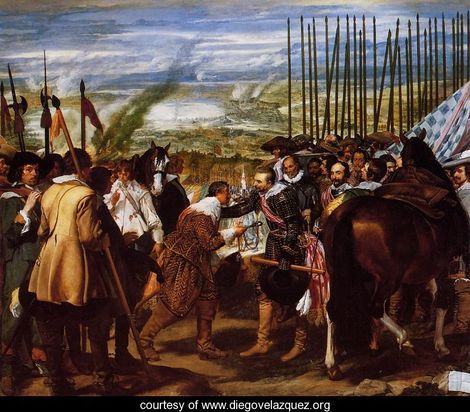| VELAZQUEZ 1599-1660 |
|
|
Born in Seville, he showed great promise for art, so studied under Herrera and then Pacheco. His reputation built during the 1620s when he produced The Adoration of the Magi and Christ and the Pilgrims of Emmaus which demonstrated his careful realism. |
|
Nacido en Sevilla, mostró una gran promesa para el arte, por lo que estudió con Herrera y luego Pacheco. Su reputación se construyó durante la década de 1620 cuando se produjo la Adoración de los Magos y Cristo y los peregrinos de Emaús, lo que demuestra su realismo cuidado. |
| In 1622 he was invited to become King Philip IV`s painter and moved to Madrid. Here he met Rubens who suggested Velazquez would gain from seeing the masters in Italy which he visited for a year in 1629. Although we know little of this period, certainly the renowned The Surrender of Breda, in 1634, was inspired by it. |
 |
En 1622 fue invitado a convertirse en el pintor del rey Philip IV y se trasladó a Madrid. Allí conoció a Rubens quien sugirió que Velázquez se beneficiaría de ver a los maestros en Italia, los cuales visitó durante un año en 1629. Aunque conocemos poco de este período, sin duda la famosa La rendición de Breda, en 1634, fue inspirada por ello. |
| When he returned to Madrid, he first started painting portraits which would become such a feature of his reputation. One of these was of the Duke of Olivares, his long-term benefactor. He also painted the King forty times together with many of the royal family. One of the best paintings from this period is the Christ on the Cross |
 |
Cuando regresó a Madrid, empezó a pintar retratos que se convertirían en una característica de su reputación. Uno de ellos era el duque de Olivares, su benefactor. También pintó el Rey cuarenta veces, junto con muchos miembros de la familia real. Una de las mejores pinturas de este período es el Cristo Crucificado |
| He visited Italy for a second time to buy art treasures for the new academy of art which King Philip set up in Madrid. During this time he painted a famous portrait of the Pope Innocent X which was heralded for its manera abreviada, a bolder and sharper style. The portrait of his servant, Juan de Pareja, which was one of his best known portraits, was a practice before he painted the Pope. |
 |
Visitó Italia por segunda vez para comprar obras de arte para la nueva academia de arte creada por el rey Felipe en Madrid. Durante este tiempo pintó un famoso retrato de la Pope Innocent X, que fue elogiado por su 'manera abreviada', un estilo más audaz y más nítida. El retrato de su criado, Juan de Pareja, que era uno de sus retratos más conocidos, fue una práctica antes de pintar el Papa. |
| On return to Spain in 1651, Velazquez painted probably his most famous work, The Maids of Honour. It is thought that the eldest daughters of the Queen, Margaret Theresa, was the subject, but there are several different viewpoints on this. Either way, it is held to be an important example of the Baroque period of art. |
 |
A su regreso a España en 1651, Velázquez pintó probablemente su obra más famosa, Las Meninas. Se cree que las hijas de la reina, Margarita Teresa, fueron las súbditas, pero hay varios puntos de vista sobre esto. De cualquier manera, se considera un ejemplo importante de la época barroca del arte. |
| Towards the end of his career, around 1557, Velazquez painted The Spinners which represented the royal tapestry works. It is regarded as encapsulating all the art knowledge that he had learned throughout his illustrious life. His final paintings of the royal children were among his best. |
 |
Hacia el final de su carrera, alrededor el año de 1557, Velázquez pintó Las hilanderas, que representaba la fábrica de tapices reales. Se piensa que esta pintura encapsula todo el conocimiento del arte que había aprendido durante toda su vida ilustre. Sus pinturas finales de los niños reales se encuentran entre sus mejores. |










